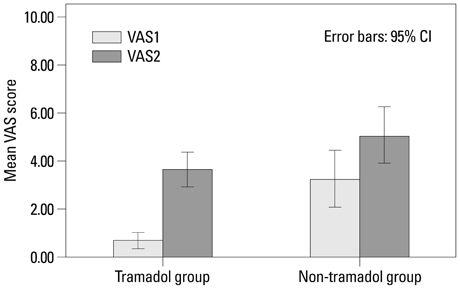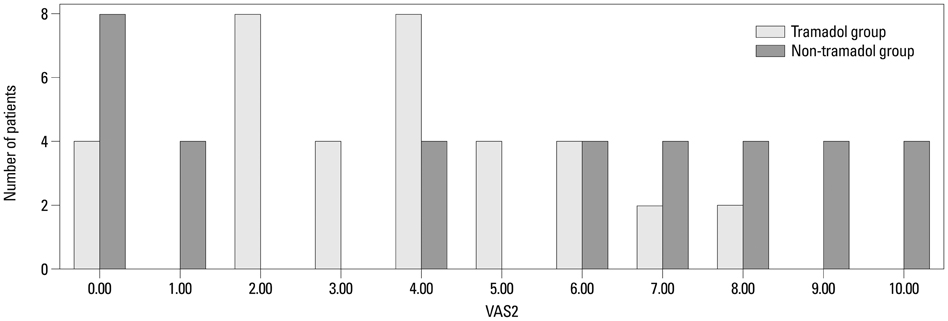Yonsei Med J.
2014 Sep;55(5):1436-1441. 10.3349/ymj.2014.55.5.1436.
Pre-Emptive Tramadol Could Reduce Pain after Ureteroscopic Lithotripsy
- Affiliations
-
- 1Clinical Center of Serbia, Urology Clinic, Department of Anesthesia, Belgrade, Serbia. anamimic@gmail.com
- 2Clinical Center of Serbia, Urology Clinic, Department of Urology, Belgrade, Serbia.
- 3School of Medicine, University of Belgrade, Belgrade, Serbia.
- KMID: 1799514
- DOI: http://doi.org/10.3349/ymj.2014.55.5.1436
Abstract
- PURPOSE
Optimal analgesia in ambulatory urology patients still remains a challenge. The aim of this study was to examine if the pre-emptive use of intravenous tramadol can reduce pain after ureteroscopic lithotripsy in patients diagnosed with unilateral ureteral stones.
MATERIALS AND METHODS
This prospective pilot cohort study included 74 patients diagnosed with unilateral ureteral stones who underwent ureteroscopic lithotripsy under general anesthesia in the Urology Clinic at the Clinical Center of Serbia from March to June 2012. All patients were randomly allocated to two groups: one group (38 patients) received intravenous infusion of tramadol 100 mg in 500 mL 0.9%NaCl one hour before the procedure, while the other group (36 patients) received 500 mL 0.9%NaCl at the same time. Visual analogue scale (VAS) scores were recorded once prior to surgery and two times after the surgery (1 h and 6 h, respectively). The patients were prescribed additional postoperative analgesia (diclofenac 75 mg i.m.) when required. Pre-emptive effects of tramadol were assessed measuring pain scores, VAS1 and VAS2, intraoperative fentanyl consumption, and postoperative analgesic requirement.
RESULTS
The average VAS1 score in the tramadol group was significantly lower than that in the non-tramadol group. The difference in average VAS2 score values between the two groups was not statistically significant; however, there were more patients who experienced severe pain in the non-tramadol group (p<0.01). The number of patients that required postoperative analgesia was not statistically different between the groups.
CONCLUSION
Pre-emptive tramadol did reduce early postoperative pain. The patients who received pre-emptive tramadol were less likely to experience severe post-operative pain.
MeSH Terms
Figure
Reference
-
1. McGrath B, Elgendy H, Chung F, Kamming D, Curti B, King S. Thirty percent of patients have moderate to severe pain 24 hr after ambulatory surgery: a survey of 5,703 patients. Can J Anaesth. 2004; 51:886–891.
Article2. Jeong BC, Park HK, Kwak C, Oh SJ, Kim HH. How painful are shockwave lithotripsy and endoscopic procedures performed at outpatient urology clinics? Urol Res. 2005; 33:291–296.
Article3. Amata A. Pain Management in Ambulatory/Day Surgery. In : Kopf A, Patel NB, editors. Guide to Pain Management in Low-Resource Settings. Seattle: IASP;2010. p. 119–121.4. Dahl JB, Møiniche S. Pre-emptive analgesia. Br Med Bull. 2004; 71:13–27.
Article5. Kissin I. Preemptive analgesia. Anesthesiology. 2000; 93:1138–1143.
Article6. Unlugenc H, Ozalevli M, Gunes Y, Guler T, Isik G. Pre-emptive analgesic efficacy of tramadol compared with morphine after major abdominal surgery. Br J Anaesth. 2003; 91:209–213.
Article7. Raffa RB, Friderichs E, Reimann W, Shank RP, Codd EE, Vaught JL. Opioid and nonopioid components independently contribute to the mechanism of action of tramadol, an 'atypical' opioid analgesic. J Pharmacol Exp Ther. 1992; 260:275–285.8. Wordliczek J, Banach M, Garlicki J, Jakowicka-Wordliczek J, Dobrogowski J. Influence of pre- or intraoperational use of tramadol (preemptive or preventive analgesia) on tramadol requirement in the early postoperative period. Pol J Pharmacol. 2002; 54:693–697.9. Carrión López P, Cortiñas Sáenz M, Fajardo MJ, Donate Moreno MJ, Pastor Navarro H, Martínez Córcoles B, et al. [Ambulatory surgery in a urology department. Analysis of the period 2003-2006]. Arch Esp Urol. 2008; 61:365–370.10. Fodale V, Tescione M, Roscitano C, Pino G, Amato A, Santamaria LB. Effect of tramadol on Bispectral Index during intravenous anaesthesia with propofol and remifentanil. Anaesth Intensive Care. 2006; 34:36–39.
Article11. Rutyna R, Popowicz M, Wojewoda P, Nestorowicz A, Białek W. [Pre-emptive ketoprofen for postoperative pain relief after urologic surgery]. Anestezjol Intens Ter. 2011; 43:18–21.12. Shen X, Wang F, Xu S, Ma L, Liu Y, Feng S, et al. Comparison of the analgesic efficacy of preemptive and preventive tramadol after lumpectomy. Pharmacol Rep. 2008; 60:415–421.13. Aida S, Baba H, Yamakura T, Taga K, Fukuda S, Shimoji K. The effectiveness of preemptive analgesia varies according to the type of surgery: a randomized, double-blind study. Anesth Analg. 1999; 89:711–716.
Article14. Møiniche S, Kehlet H, Dahl JB. A qualitative and quantitative systematic review of preemptive analgesia for postoperative pain relief: the role of timing of analgesia. Anesthesiology. 2002; 96:725–741.
Article15. Katz J, Schmid R, Snijdelaar DG, Coderre TJ, McCartney CJ, Wowk A. Pre-emptive analgesia using intravenous fentanyl plus low-dose ketamine for radical prostatectomy under general anesthesia does not produce short-term or long-term reductions in pain or analgesic use. Pain. 2004; 110:707–718.
Article16. McQuay HJ. Pre-emptive analgesia. Br J Anaesth. 1992; 69:1–3.
Article
- Full Text Links
- Actions
-
Cited
- CITED
-
- Close
- Share
- Similar articles
-
- Pre-emptive analgesia efficacy of piroxicam versus tramadol in oral surgery
- Ureteroscopic Lithotripsy under Local Anesthesia: Analysis of the Effectiveness and Tolerability
- Use of NTrap(R) during Ureteroscopic Lithotripsy for Upper Ureteral Stones
- Shock after Ureteroscopic Lithotripsy: A case report
- The Comparison of Ureteroscopic Lithotripsy Between Laser and Electrohydraulic Lithoriptor



